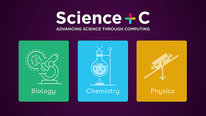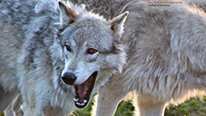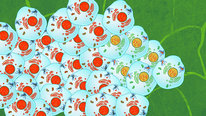- Rachel Chaffee
- http://www.rachelchaffee.com
- Senior Education Researcher
- Presenter’s NSFRESOURCECENTERS
- American Museum of Natural History
- Preeti Gupta
- https://pgupta10.wixsite.com/preetigupta
- Director of Youth Learning and Research
- Presenter’s NSFRESOURCECENTERS
- American Museum of Natural History
- Irene Lee
- https://www.linkedin.com/in/irene-a-lee/
- Research scientist
- Presenter’s NSFRESOURCECENTERS
- MIT STEP Lab, Education Development Center (EDC), American Museum of Natural History
Decoding Urban Ecosystems: Computational Thinking Integration in Middle Schoo...
NSF Awards: 1934039
2022 (see original presentation & discussion)
Grades 6-8
American Museum of Natural History in partnership with Project GUTS has launched a three-year project to design, implement and study a program that engages 125 NYC middle schoolers in a 3-week CT-integrated science summer institute. The curriculum aims to simultaneously engage youth with ecosystem dynamics and use CT practices in the context of computer modeling and simulations. The research focuses on documenting the impact of the intervention on students’ learning of CT and ecosystem concepts and developing a better understanding of what connections youth make between CT practices evident in coding/decoding and understanding of complex scientific processes. Working with Education Design Associates, self-efficacy is also being documented to detect shifts in their beliefs about modeling, computer modeling, and STEM learning.
The curriculum had a series of activities to introduce students to increasingly advanced CT processes in the context of Lyme disease and the NYC ecosystem. Many activities provided students with the opportunity to demonstrate mechanistic reasoning in conversation with their peers and instructors and in written reflections, and had many opportunities to engage in the “Use-Modify-Decode-Create” continuum. The goal was to address the key aspects of CT: Analysis, Abstraction, and Automation.
We will describe what we have learned about the development, implementation and refinement of an integrated curriculum and our ongoing efforts to gauge how participation in the curricular activities has led to gains in CT knowledge and skills.. We also hope to launch discussions with you on key aspects of the project that have field-wide implications.
Related Content for Investigating Lyme Disease through Decoding Models
-
 2021Decoding Urban Ecosystems: CT in Middle School STEM
2021Decoding Urban Ecosystems: CT in Middle School STEM
Preeti Gupta
-
 2021Framing Computer Modeling as a Social Justice Issue
2021Framing Computer Modeling as a Social Justice Issue
Irene Lee
-
 2022Introducing All Students to CS Within Core Science Courses
2022Introducing All Students to CS Within Core Science Courses
Joyce Malyn-Smith
-
 2021Connecting Math and Science through Decoding Models
2021Connecting Math and Science through Decoding Models
Aditi Wagh
-
 2021Collaboration Dynamics and Culturally Responsive Teaching
2021Collaboration Dynamics and Culturally Responsive Teaching
Meredith Kier
-
 2019Using Agent-Based Modeling Collaboratively
2019Using Agent-Based Modeling Collaboratively
Anthony Petrosino
-
 2022EvoMedEd - Teaching Intro Bio using Evolutionary Medicine
2022EvoMedEd - Teaching Intro Bio using Evolutionary Medicine
Peter White
-
 2022Science Education in the New Normal: Role of Citizen Science
2022Science Education in the New Normal: Role of Citizen Science
Russanne Low



Preeti Gupta
Director of Youth Learning and Research
Welcome to our project everyone! We are excited to share what we have developed, how our pilot testing is going and what we are learning about the impact of the curriculum via our mixed-methods study. Ask us details about the curriculum, and the process of developing an integrated science and CT program (not an easy thing to do). We invite you to probe us on the instruments we used and how we did data collection, and what we are learning! And don't forget...this whole project is happening during a pandemic. Ask us how we managed recruitment, online teaching of such content, getting parents to give consent and everything in between! Looking forward to discussing with you!
Anita Crowder
Amazing project! I love the use of simulations and modeling as a vehicle for CT. Were your instructors/facilitators from the American Museum of Natural History? And did your instructors go through the Project GUTS professional development or did you create a special PD for this project? Thank you for sharing your work.
Preeti Gupta
Director of Youth Learning and Research
Yes..to launch this project we have AMNH staff who both developed the curriculum and taught it the first two times. We worked closely with Project GUTS to learn the tools and all of the capabilities and working with co-PI Irene Lee, I might say that we even pushed the boundaries a bit. What say you Irene? (I wish there was a way to tag you in this comment). Our hope is that after the pilot period, we can consider adapting this in partnership with the NYC Dept of Education for use in schools. To that end, we have four lead teachers as co-researchers on the project. I can tell you more about that if you are interested!
Anita Crowder
Anita Crowder
Thank you for the response! Having teachers on board is so important, and incorporating this into NYC schools would be quite the bump in scale! Very exciting. I am looking forward to following your project's progress and learning more.
Irene Lee
Research scientist
Hi Anita, Great to see you here!
I met with Gabrielle Rabinowitz, the lead curriculum designer / instructor for the DecodeNYC project, to review StarLogo Nova models, pedagogy, and learnings from Project GUTS. We did not run through the Project GUTS PD in full. As an experienced CS instructor and scientist, Gabrielle was adept in understanding the Use-Modify-Create progression, the models, and the Project GUTS approach.
In Project GUTS, we engaged students in reasoning about what an agent did (how it moved and interacted with other agents) from an "execution of code" perspective. In DecodeNYC, we go deeper and have students identify the scientific process that this action/interaction represents. Gabrielle did a wonderful job weaving this connection between mechanisms in code and the scientific processes they represent throughout the DecodeNYC curriculum.
--Irene
Gabrielle Rabinowitz
Thanks Irene! I'll add that other educators at AMNH were also trained to teach the DecodeNYC curriculum. In addition to learning StarLogo Nova, they were also introduced to the Use-Modify-Create process and the nature of decoding. This was pretty intuitive for them, especially since they typically followed U-M-C themselves while learning the software!
Channa Comer
STEM Educator
Hello and thank you for sharing your project. Integrating computational thinking along with content understanding is an ambitious task!
Can you share more about the use-modify-decode-create process (which reminds me of a design-thinking process), why you chose to focus on the decode step, and what that means for student learning? Why do you think it is important for students to have an understanding of computational thinking? In your video, you mention one of the impacts on student learning as being the ability to map code segments to the scientific process. How were students taught about the scientific process? What are some other positive impacts on student learning? Were any of the positive impacts content-related?
Gabrielle Rabinowitz
Hello Channa! I'm the educator who wrote and facilitated the curriculum. I'd be happy to tell you a little more about the use-modify-create process. We're building on the work done by Project GUTS which established the U-M-C process as one that scaffolds increasingly deep interactions with CT. I agree that it has a lot in common with design-thinking!
The decoding aspect of the process hasn't been studied as extensively as the simpler Use-Modify-Create flow and we were curious to see if emphasizing the mapping between real world scientific phenomena and a computational model would help learners develop a stronger understanding of both the science and CT.
Computational thinking is a skill that young people will be able to apply to a wide variety of academic and professional fields, so we hope that empowering them to feel comfortable with it early on will set them up for success. It's another tool in their toolkit for inquiry.
The scientific processes we focused on in the curriculum were ecosystems, population dynamics and disease transmission. We taught these concepts in a variety of ways, including hands on activities and a virtual "field trip" with tick researchers. We also believe that decoding, and modeling in general, encouraged students to engage deeply with these concepts.
I'll let Preeti and Irene speak to the measurable impacts from the instruments, but I can say that students certainly learned a lot about both modeling and ecosystems and how to use one to study the other!
Sue Allen
Senior Research Scientist
Maybe you can help me understand this - I'm still confused about the different representations. There's the code, the visual simulation of red ticks etc, and then something else related to the real world? Are they connecting among 3 worlds? If it's only two (code and sim) then I don't understand why they're figuring out "what maps and what doesn't" - surely the sim just shows what they've coded? A related question I have is: how is this different from, say, using Scratch? Are there some initial parameters you set that reflect an ecosystem rather than simple programmable objects? Maybe it would help me to hear a couple of concrete examples of the kinds of things youth do in the different representations, and what they infer. Thanks!
Gabrielle Rabinowitz
Hi Sue Allen,
The code controls everything that happens in the visual simulation. There is code to place the ticks, turn them red when infected, tell them how to move, etc. This is the agent-based model. Students are making connections between this model (at both the agent-based level and the code level when they have learned more) and the real world ecosystem. An example of that mapping might be: "The model needs to include code to turn mice red because this represents what happens in the real world when an infected tick bites a mouse", or "Since in the real world we can put pesticides on deer, we can add code to the model so that some ticks disappear when they collide with deer." Students might also make discoveries about the real world based on what they observe in the model. For example, "I noticed that deer never turned red. That makes me wonder if they can be infected too."
The biggest difference between StarLogo Nova and Scratch is that StarLogo Nova is built with scientific modeling in mind. There are easy ways to add line graphs and encode the kinds of behaviors typical of agent-based models. In SLNova there are no initial parameters. Everything is built from code! Each "breed" of agent and all of its behaviors are encoded based on the code blocks.
I hope that helps!
Sue Allen
Senior Research Scientist
Extremely helpful, thanks!
Irene Lee
Research scientist
Hello Channa,
Thanks for your question about student impacts. Here's a summary of content-related impacts...
Year 1 data analysis focused on the survey results from the KS-CT Survey Data. The KS-CT Survey contains 4 scales: Ecosystem concepts; CS concepts; trace code and predict outcome; and match coded sequences to scientific processes.
Findings show that the Decode-CT program had a statistically significant positive impact on students' learning. From pre to post test, students in the treatment group (n = 18) increased their KS-CT scores by an average of 2.44 points out of a total of 20 points, whereas students in the comparison group (n = 10) increased their KS-CT scores by an average of 0.2 points out of a total of 20 points. The scale with the largest increase was the mapping of code segments to the scientific processes they represent.
--IreneNickolay Hristov
Senior Scientist, Associate Professor, Director
Important work! I enjoyed watching the video. It tackles very well the difficult task of explaining the computational thinking curriculum, the decoding process and the biological system. The visual narrative flows very well too. The elements at 02:15-02:25 and 02:25-02:40 particularly stand out. The credit slide is only flashed for a brief moment but it was good to see the creative team recognized. Kudos for the overall result. Can you say something about how that collaboration took shape? Did anything stand out in the process?
Preeti Gupta
Director of Youth Learning and Research
Hi Nickolay,
We have several types of collaborations. The collaboration for the design of the curriculum and the associated study is between American Museum of Natural History and Project GUTS. We also had collaborators at Columbia University to support our scientific work and to ensure our models were accurate and representing actual research. We had collaborations with schools from which we recruited students. We also have four teacher co-researchers who have been instrumental in supporting the research work and will play a deeper role in the coming year to support our thinking on how this work can impact formal school settings. And to put it in context, it all happened as the pandemic started. So the collaboration work is always hard but was a bit more complex due to the constraints of the pandemic. In terms of process of writing the curriculum, there was a lot of back and forth and organizing of goals and writing of outlines and proofing and vetting and you get the picture. What stands out when doing this type of innovative work is the importance of being organized, meeting weekly during the process and crafting a team of people with different talents and expertise.
Leah Rosenbaum
Thank you for building and sharing out this work! I'm curious how you chose Lyme disease spread in particular. Also, do you mind sharing more about how students compared the results of their coded models to real-world data and their experiences or knowledge of Lyme's disease. What did that comparison process look like? How did it subsequently affect their model design?
I'm on a team working on a very related project (our Showcase video is here) looking at how middle school students integrate real-world data into agent-based computer models of scientific phenomena. Maybe we can think together about how students compare modeled and real-world data!
Gabrielle Rabinowitz
Hi Leah,
We chose Lyme disease spread for a couple of reasons- partially because the ecosystem involved can be found locally (on Staten Island) and also because of the scientific expertise of our staff scientists and collaborators on the project.
While we didn't use a lot of numerical real-world data, we did encourage students to look for evidence of real-world ecosystem dynamics in the output of their models. Additionally, students tested real world Lyme disease intervention strategies (such as vaccinating mice or putting pesticides on deer) using their models in order to evaluate their efficacy. When students added their own species to the Lyme disease model near the end of the program, they learned about those animals' real-world interactions with the Lyme disease ecosystem and then worked to model those realistically.
Your project is very exciting as well! I love the inclusion of video evidence of the phenomena alongside the modeled behavior. Let's definitely stay in touch!
Preeti Gupta
Director of Youth Learning and Research
Leah - what a great video..so explanatory! Ok we need our project teams to talk and have a retreat or something! I am tagging Gabrielle, our curriculum designer and educator to answer your specific question more thoroughly!
Sue Allen
Senior Research Scientist
This sounds like a very interesting project, and I really like the U-M-C cycle as a way into computational thinking. I just wish I understood better what youth are doing & thinking during the decoding process (esp if it's innovative and emphasized). Thanks!
Lauren Bauman
Very cool video! I loved your animations! In addition to the skills survey, did you collect any other data about the curriculum's other impacts? For example, I'd be interested if the students who participated had an increased interest in computer modelling/related fields, or maybe they saw gains in their school classes during the following year? Are there any other dimensions along which you're measuring impact?
Preeti Gupta
Director of Youth Learning and Research
HI Lauren,
We are measuring self-efficacy, interest in CS careers, change in understanding of ecosystem ideas, chance in understanding of CT concepts and then change in whether youth are able to connect the coding blocks to an ecological concept. This is all via surveys. Our pre-post artifact-based interviews are focused on mechanistic reasoning skills, an area that youth struggle with when studying ecology, and two other ideas. In that interview we are seeing if youth are able to describe what they are seeing in a model, what each parts mean, and manipulation of the model impacts the model and then whether they can connect the block-based code to activity in the model. For example, "what is the block Procedure: Wiggle" telling us?". We are looking to see if youth can accurately describe what the code is doing in the model and then if we alter some numbers on the code, how does that affect the model. We also ask what the model is representing in real life and where the model is lacking in representing aspects of real life.
In addition to interviews and surveys, we have exit ticket data, google form data from classroom activities and field observations.
We didn't have the ability at this time to collect data on whether the program is impacting their choices of classes or gains in school. We were curious if the program impacted their choice of high school because in NYC, you don't go to your zone school - you can apply anywhere. We did not collect that data though. These are aspirations and with maybe some funding in the future, we can do a retrospective look at these participants and choices they felt they made as impacted by the program.
We have so so so much data and that is good thing. Now we are trying to get some analysis complete and start sharing it out.
Further posting is closed as the event has ended.